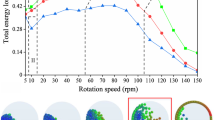Abstract
The Magnus effect and the reverse Magnus effect are studied on golf balls and on smooth balls, each of which are moving in still air. The fluid motion around the balls is measured using 2-component particle image velocimetry (PIV). The PIV data are used to compute the out-of-plane component of vorticity, and the vorticity field, along with the velocity field, is used to find the locations and state of the boundary layers at separation on the top and bottom of the ball. The reverse Magnus effect occurs when the spin is sufficient to cause the retreating boundary layer to be laminar, while the advancing side is turbulent. The reverse Magnus regime ends when the retreating side becomes turbulent due to the separation point moving into a strong adverse pressure gradient on the rear of the ball.
Graphic abstract











Similar content being viewed by others
References
Alaways LW (1998) Aerodynamics of the curve-ball: an investigation of the effects of angular velocity on baseball trajectories. Ph.D. thesis, University of California, Davis
Barlow JB, Domanski MJ (2008) Lift on stationary and rotating spheres under varying flow and surface conditions. AIAA J 46(8):1932–1936. https://doi.org/10.2514/1.28129
Bearman PW, Harvey JK (1976) Golf ball aerodynamics. Aeronaut Q 27(2):112–122. https://doi.org/10.1017/s0001925900007617
Beratlis N, Squires K, Balaras E (2012) Numerical investigation of Magnus effect on dimpled spheres. J Turbul 13(January):1–15. https://doi.org/10.1080/14685248.2012.676182
Briggs LJ (1959) Effect of spin and speed on the lateral deflection (curve) of a baseball; and the Magnus effect for smooth spheres. Am J Phys 27(8):589–596. https://doi.org/10.1119/1.1934921
Bush JWM (2013) The aerodynamics of the beautiful game. In: Clanet C (ed) Sports physics. Les Editions de l’Ecole Polytechnique, pp 171–192. http://hdl.handle.net/1721.1/87576. Accessed 6 Jan 2020; 9 Apr 2020
Davies JM (1949) The aerodynamics of golf balls. J Appl Phys 20(9):821–828. https://doi.org/10.1063/1.1698540
Kensurd J (2018) Flex grip sports ball pitching machine tip. PCT/US2017/032887
Kim J, Choi H, Park H, Yoo JY (2014) Inverse Magnus effect on a rotating sphere: when and why. J Fluid Mech 754:R2. https://doi.org/10.1017/jfm.2014.428
Kray T, Franke J, Frank W (2012) Magnus effect on a rotating sphere at high Reynolds numbers. J Wind Eng Ind Aerodyn 110:1–9. https://doi.org/10.1016/j.jweia.2012.07.005
Li J, Tsubokura M, Tsunoda M (2017) Numerical investigation of the flow past a rotating golf ball and its comparison with a rotating smooth sphere. Flow Turbul Combust 99(3–4):837–864. https://doi.org/10.1007/s10494-017-9859-1
Lyu B, Kensrud J, Smith L (2020) The reverse Magnus effect in golf balls. Sports Eng 23(1):3. https://doi.org/10.1007/s12283-020-0318-1
Maccoll JW (1928) Aerodynamics of a spinning sphere. J R Aeronaut Soc 32(213):777–798. https://doi.org/10.1017/S0368393100136260
Muto M, Tsubokura M, Oshima N (2012a) Negative Magnus lift on a rotating sphere at around the critical Reynolds number. Phys Fluids. https://doi.org/10.1063/1.3673571
Muto M, Tsubokura M, Oshima N (2012b) Numerical visualization of boundary layer transition when negative Magnus effect occurs. J Vis 15(3):261–268
Rott N (1956) Unsteady viscous flow in the vicinity of a stagnation point. Q Appl Math. https://doi.org/10.1090/qam/74194
Sciacchitano A, Wieneke B (2016) PIV uncertainty propagation. Meas Sci Technol. https://doi.org/10.1088/0957-0233/27/8/084006
Seifert J (2012) A review of the Magnus effect in aeronautics. Prog Aerosp Sci 55:17–45. https://doi.org/10.1016/j.paerosci.2012.07.001
Swanson WM (1961) The Magnus effect: a summary of investigations to date. J Basic Eng 83(3):461–470. https://doi.org/10.1115/1.3659004
Taylor J (2014) The science of soccer: a bouncing ball and a banana kick. UNM Press, Albuquerque
Tokaty GA (1994) A history and philosophy of fluid mechanics. Courier Corporation, North Chelmsford
Westerweel J, Scarano F (2005) Universal outlier detection for PIV data. Exp Fluids 39(6):1096–1100. https://doi.org/10.1007/s00348-005-0016-6
Acknowledgements
The authors would like to thank Professor Lloyd Smith and Jeff Kensrud of the Washington State University Sports Sciences Laboratory for financial support, the use of the cannon and the suggestion of this study.
Author information
Authors and Affiliations
Corresponding author
Additional information
Publisher's Note
Springer Nature remains neutral with regard to jurisdictional claims in published maps and institutional affiliations.
Rights and permissions
About this article
Cite this article
Sakib, N., Smith, B.L. Study of the reverse Magnus effect on a golf ball and a smooth ball moving through still air. Exp Fluids 61, 115 (2020). https://doi.org/10.1007/s00348-020-02946-2
Received:
Revised:
Accepted:
Published:
DOI: https://doi.org/10.1007/s00348-020-02946-2




